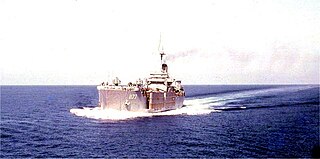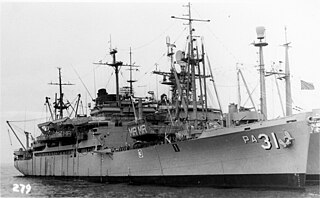
USS Trenton (LPD-14), an Austin-class amphibious transport dock, was the third ship of the United States Navy to be named for the capital of New Jersey. In 2007, it was sold to the Indian Navy and renamed INS Jalashwa (L41).

The third USS Adirondack (AGC-15) was laid down on 18 November 1944 under a Maritime Commission contract by the North Carolina Shipbuilding Company in Wilmington, North Carolina; launched on 13 January 1945, sponsored by Mrs. E. L. White; transferred to the Navy on 4 February 1945; towed to the Philadelphia Naval Shipyard for conversion; and commissioned on 2 September 1945, the day Japan surrendered on board the battleship Missouri (BB-63) in Tokyo Bay, with Captain R. O. Myers in command.

USS Vermilion (AKA-107/LKA-107), was a Tolland-class attack cargo ship of the United States Navy, named after a parish in southern Louisiana and a county in eastern Illinois. She served as a commissioned ship for 25 years and 9 months.

USS Liddle (DE-206/APD-60), a Buckley-class destroyer escort of the United States Navy, in service from 1943 to 1946. She was recommissioned from 1950 to 1959 and from 1961 to 1967, before being sold for scrap.
USS York County (LST-1175) was a De Soto County-class tank landing ship built for the United States Navy during the late 1950s. The lead ship of her class of seven, she was named after counties in Maine, Nebraska, Pennsylvania, South Carolina, and Virginia, she was the only U.S. Naval vessel to bear the name.

USS Pocono (AGC-16) was an Adirondack-class amphibious force command ship named after a range of mountains in Eastern Pennsylvania. She was designed as an amphibious force flagship, a floating command post with advanced communications equipment and extensive combat information spaces to be used by the amphibious forces commander and landing force commander during large-scale operations.

USS Botetourt (APA-136) was a Haskell-class attack transport built and used by the US Navy in World War II and saw further service during the Korean War. She was a Victory ship design, VC2-S-AP5. She was named after Botetourt County, Virginia, United States.

USS Blanco County (LST-344) was an LST-1-class tank landing ship built for the United States Navy during World War II. Named for Blanco County, Texas, she was the only U.S. Naval vessel to bear the name.
USS Terrebonne Parish (LST-1156), originally USS LST-1156, affectionately nicknamed the "T-Bone" by her early crew, was a Terrebonne Parish-class tank landing ship built for the United States Navy in 1952. The lead ship in her class, she was named for Terrebonne Parish, Louisiana, the only U.S. Navy vessel to bear the name. The ship was later transferred to Spain and renamed Velasco (L-11), and was scrapped in 1994.

USS Suffolk County (LST-1173) was a De Soto County-class tank landing ship built for the United States Navy during the late 1950s. Named after counties in Massachusetts and New York, she was the only U.S. Naval vessel to bear the name.

USS Lorain County (LST-1177) was a De Soto County-class tank landing ship built for the United States Navy during the late 1950s. Named after Lorain County, Ohio, she was the only U.S. Naval vessel to bear the name.

USS Monrovia (AP-64) was a Crescent City class attack transport of the United States Navy, built from a C-3 Delta commercial freighter design, and was named for the Birthplace of President James Monroe, located in Westmoreland County, Virginia.
USS Ouachita County (LST-1071) was an LST-542-class tank landing ship built for the United States Navy during World War II. Named for Ouachita County, Arkansas, she was the only U.S. Naval vessel to bear the name.

USS Walworth County (LST-1164), previously USS LST-1164, was a United States Navy landing ship tank (LST) in commission from 1953 to 1971, and which then saw non-commissioned Military Sealift Command service as USNS Walworth County (T-LST-1164) from 1972 to 1973.

USS Waldo County (LST-1163), previously USS LST-1163, was a United States Navy landing ship tank (LST) in commission from 1953 to 1970, and which then saw non-commissioned Military Sealift Command service as USNS Waldo County (T-LST-1163) from 1972 to 1973.

USS Beacon (PGM-99/PG-99) was a Asheville-class gunboat in the United States Navy during the Vietnam War. She was transferred to the Hellenic Navy where she serves as PG Hormi.

USS Walsh (APD-111) was a United States Navy Crosley-class high-speed transport in commission from 1945 to 1946. She was scrapped in 1968.

USS Ruchamkin (APD-89), ex-DE-228, later LPR-89, was a United States Navy high-speed transport in commission from 1945 to 1946, from 1951 to 1957, and from 1961 to 1969. She subsequently served as ARC Córdoba in the Colombian Navy, until 1980; although scrapped, her hull and superstructure were re-erected in a leisure park near Bogotá.

USS Kirwin (APD-90), ex-DE-229, later LPR-90, was a United States Navy high-speed transport in commission from 1945 to 1946 and from 1965 to 1969.

USS Bassett (APD-73), ex-DE-672, was a United States Navy high-speed transport in commission from 1945 to 1946 and from 1950 to 1957.

















